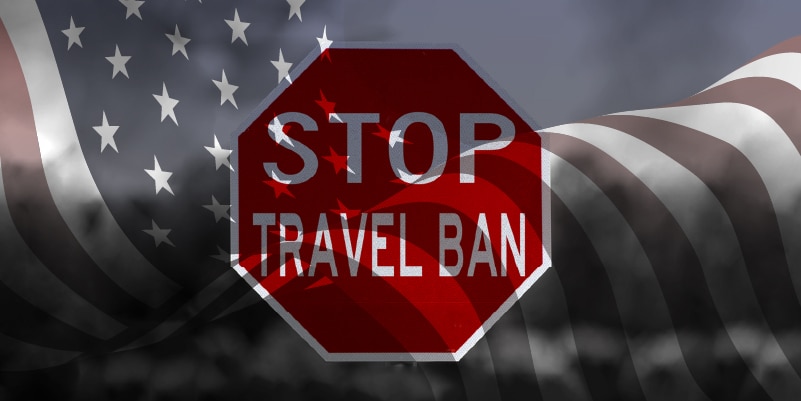
The U.S. government is allegedly finalizing a new travel ban prohibiting or restricting entry for citizens from dozens of countries, primarily in Africa and the Middle East, according to recent media reports. The list includes countries from Russia and Pakistan to Iran and Mauritania.
“Now, in 2025, a new executive order has launched a 60-day review to assess security vetting procedures in over 40 countries, potentially leading to a new travel ban,” said EB-5 attorney Marjan Kasra of Lawmaks. “A leaked draft of the proposal outlines a tiered system of restrictions, with the most severe limitations—possibly a full travel suspension — targeting ‘Red Zone’ countries such as Afghanistan and Iran.”
However, the Department of State (DOS) has denied these claims, arguing that the list released by the media does not exist.
How could a U.S. travel ban affect EB-5 investors?
U.S. immigration attorney Yuliya Veremiyenko-Campos from YVC Legal says that a potential travel ban could affect those awaiting immigrant visa interviews at U.S. consulates abroad.
“If the ban prevents visa issuance, these investors may see their cases placed on indefinite hold, leaving their capital tied up in EB-5 projects without a clear pathway to a green card,” he said. “This uncertainty raises serious concerns about exit strategies and potential refunds, which could, in turn, negatively affect EB-5 projects reliant on foreign investment.”
Meanwhile, for investors already residing in the U.S. under another visa and applying for EB-5 visas, the travel limitations could pose challenges if they plan to leave the country during their application process.
Immigration attorney Tony Wong from Wong & Associates cautions investors from banned or restricted countries not to leave the U.S. if they have already applied and have another visa status.
Similarly, for those who filed concurrently with an I-485 form, “they should not leave the U.S. because they are very likely not allowed to come back even though they have advance parole. For some who are going to file I-526 or I-526E and are in the U.S., they should consider the concurrent filing of I-485 and stay in the U.S. for the adjustment of status,” Wong concludes.
If such a list existed, Veremiyenko-Campos adds, “I’d recommend to all my clients from affected countries to refrain from international travel.”
EB-5 lawyer Jimena Cabrera from the Law Office of Jimena G. Cabrera stated that there is uncertainty about how a ban can affect people already in the U.S. with another immigration status.
“Historically, people already present in the United States, potentially processing an adjustment of status or holding a nonimmigrant visa and planning to file for adjustment based on an EB-5 investment, have not been affected. However, this remains uncertain.”
Cabrera also cautioned that the travel ban might deter foreign investors from affected countries from investing in the U.S. in exchange for a green card, even if the country faces some restrictions rather than an outright ban.
“Additional scrutiny and visa limitations could delay the processing of EB-5 applications, leading to uncertainty for investors,” she said.
According to EB-5 attorney Marjan Kasra from Lawmaks, if a ban is implemented, the U.S. Citizenship and Immigration Services ( USCIS) will likely continue processing applications, just as it did during Trump’s previous travel ban.
“This means that filing now remains a viable option, and any potential restrictions will likely only become an issue at the consular stage, potentially months or even years down the line. At that point, applicants may need to seek waivers or other exemptions to secure their visas.”
How did Trump’s previous travel bans affect EB-5 applications?
President Trump’s first travel ban, issued in January 2017, was an executive order that temporarily barred entry to the U.S. for citizens from seven countries: Iran, Iraq, Libya, Somalia, Sudan, Syria, and Yemen. The ban faced significant legal challenges and sparked widespread protests, leading to its revision and re-issuance in March 2017.
Cabrera said affected EB-5 investors “had to file a waiver to the ban (if they qualified), which added months to the process.”
Veremiyenko-Campos also recalls that although these countries were not traditionally countries with a high volume of EB-5 petitions, the restrictions “caused a lot of anxiety and uncertainty for individuals travelling from the affected countries.”
Kasra remembers that despite its broad restrictions, the USCIS “continued processing petitions, meaning that many affected individuals were only impacted once their cases reached the consular stage.
She concludes, “While this news is concerning, it is not the end of the road. During the last travel ban, waivers were granted on a case-by-case basis to individuals who could demonstrate that they posed no national security risk, that their entry was in the national interest, and that they would suffer undue hardship if denied.”
In addition, the EB-5 attorneys recommend that their clients plan travel accordingly, given the uncertainty surrounding this developing policy.
DISCLAIMER: The views expressed in this article are solely the views of the author and do not necessarily represent the views of the publisher, its employees. or its affiliates. The information found on this website is intended to be general information; it is not legal or financial advice. Specific legal or financial advice can only be given by a licensed professional with full knowledge of all the facts and circumstances of your particular situation. You should seek consultation with legal, immigration, and financial experts prior to participating in the EB-5 program Posting a question on this website does not create an attorney-client relationship. All questions you post will be available to the public; do not include confidential information in your question.








